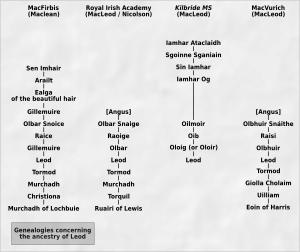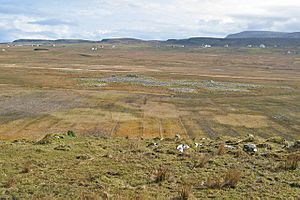Páll Bálkason facts for kids
Quick facts for kids
Páll, son of Bálki
|
|
|---|---|
| Died | 1231 |
| Opponent(s) | Gofraid Donn |
| Children | 1 son |
| Parent(s) | Bálki |
| Relatives | Foster father of Leod |
Páll, son of Bálki, or Paal Baalkeson, was a 13th-century Hebridean lord who was an ally of Olaf the Black, king of Mann and the Isles. He was long remembered in Gaelic tradition and is traditionally the progenitor of certain families with roots in the Hebrides. Páll is recorded as being a "sheriff" of Skye, a post which had earlier been held by another Páll, son of Bálki, who was possibly an ancestor. This earlier sheriff was said to have been a close friend of Godred II, King of Mann and the Isles.
Background
Much of the contemporary knowledge of Páll comes from his appearances in the mediaeval Chronicle of Mann and later MacLeod tradition. Within the Chronicle of Mann he is named as Paul filius Boke, and is titled as a vicecomes of Skye. This title has usually been translated into English as "sheriff", since it is the regular form of "sheriff" in later times in Scotland. According to W.D.H. Sellar, it is more likely that vicecomes refers to a Norse title, such as syslumadh or armadhr (Gaelic: armann). His title appears to show that he was the official representative of the kings of Man on Skye. In later Gaelic tradition, Páll is portrayed as a "hermit"; it has been suggested that this description may actually refer to this Norse title.
The post of "sheriff" had at one time been earlier been held by another Páll, son of Bálki who was possibly an ancestor of Páll. This earlier sheriff was said to have been a close friend of Godred II of Mann and the Isles. The early 20th-century historian W.C. Mackenzie related how Somerled had his sights set on becoming king in the Hebrides; his own son, Dugald, was paraded through the Hebrides and proclaimed king, with the local chieftains called upon to support his claim. Most of the chieftains, however, refused to give their support, including Páll's predecessor, Páll, son of Bálki. Upon refusing to swear his allegiance to Dugald, this Páll, son of Bálki fled to the Isle of Man, where he alerted the king of Somerled's treachery. Godred II immediately sent a fleet to the Hebrides to crush the insurrection; however, Somerled was waiting for him, and the opposing fleets met in battle. Both sides fought into the night; by morning Godred II and Somerled agreed to a truce and agreed to divide the Hebrides between them. Somerled retained the islands south of Ardnamurchan and Godred II retained those to the north. Mackenzie stated that this treaty dates to the year 1156 and marks the date on which the South Isles passed permanently from the dominion of the Kings of Mann.
Location of the "island of Saint Columba"
It has sometimes been stated that the "Saint Columba's Isle" mentioned to in the Chronicle of Mann, may in fact represent the Inner Hebridean island of Iona, which is known in Scottish Gaelic as Ì Chaluim Chille. There have been several other islands suggested—all of which are located on, or near, Skye. One such location is the "Island of St. Colm", near Portree at Skeabost; suggested by historian Alick Morrison. Sellar, however, noted that Morrison gave no evidence in support of this location. Another proposed location is the "Island of St Columba", which is situated in the middle of the river Snizort; and which is located only few hundred yards from the sea. This island was for a time, the site of a mediaeval cathedral; it is also the site of the traditional burial grounds of the MacNeacails of Scorrybreac. Sellar proposed another location, which he considered to be a much more likely candidate for the isle where Olaf and Páll attacked Godred Donn. This was Eilean Chaluim Chille, at Kilmuir, Skye. This island was originally in the middle of Loch Chaluim Chille, located at grid reference NG37706885; though the long was drained in the 18th century. Sellar asserted that this location fit perfectly with the location described in the Chronicle of Mann. He also noted that the island was associated in local tradition with a man who is now thought to represent Páll.
Legacy
Páll has long been remembered in Gaelic tradition. One tradition, still recounted in the early 20th century in the vicinity of Kilmuir, concerned a man described as Fear Caisteal Eilean Chaluim Chille ("the man of the castle of Eilean Chaluim Chille")—a man considered to represent the historical Páll. The Bannatyne manuscript states that Paal Baccas had a natural son, from whom descended a family that held the island of Berneray and other lands on Harris under the MacLeods. It continues that the family was once powerful and numerous, but it fell into decline until only a few remained. The manuscript names this family as Clan Vic Phaich and states that they prided themselves in their descent from Paal Baccas. This Berneray family is today surnamed MacKillop; yet they are known in Scottish Gaelic as MacPhàic. Matheson stated that their traditional Gaelic name presumably referred to Bálki, father of Páll; or perhaps to a son of Páll who was also named Bálki. Matheson proposed that the MacPhails, originally from the Sand district on North Uist, and those from Carloway on Lewis, derived their surname from Páll. There is a township on the northern tip of the Island called Baile Mhicphail (Macphail's village).

According to Matheson, the MacLeods are male-line descendants of Páll's father. Matheson proposed that three of the four genealogies relevant to Leod's ancestry (pictured right), show that Leod was the grandson of Bálki; that the names Raice, Raoige, Raisi were garbled Gaelic forms of the Old Norse name Bálki. Matheson added more weight to his argument by noting that the 17th century Gaelic poet Duncan Macrae of Inverinate, referred within a song to the MacLeod chief Roderick MacLeod of Dunvegan (chief 1693–1699) as éighre Shìol Phàic (the "heir of the seed of Bálki"). Matheson speculated that if Leod, founder of Clan MacLeod, was the nephew of Páll, then this may help explain why MacLeod tradition states that Paal Baccas left his estates to Leod, instead of his own (illegitimate) son. Matheson's proposal was, however, met with considerable criticism from his peers. The three Gaelic names singled out by Matheson are not considered to represent Bálki. Sellar proposed the names represented the Gaelic Raingce; while A.P. MacLeod proposed they equated the very rare Old Norse name Ragi. The current consensus is that Matheson could not have been correct in his proposed relationship between Leod and Páll's father; meaning that Macrae of Inverinate's "heir of the seed of Bálki" must have referred to a non-male-line descent.


